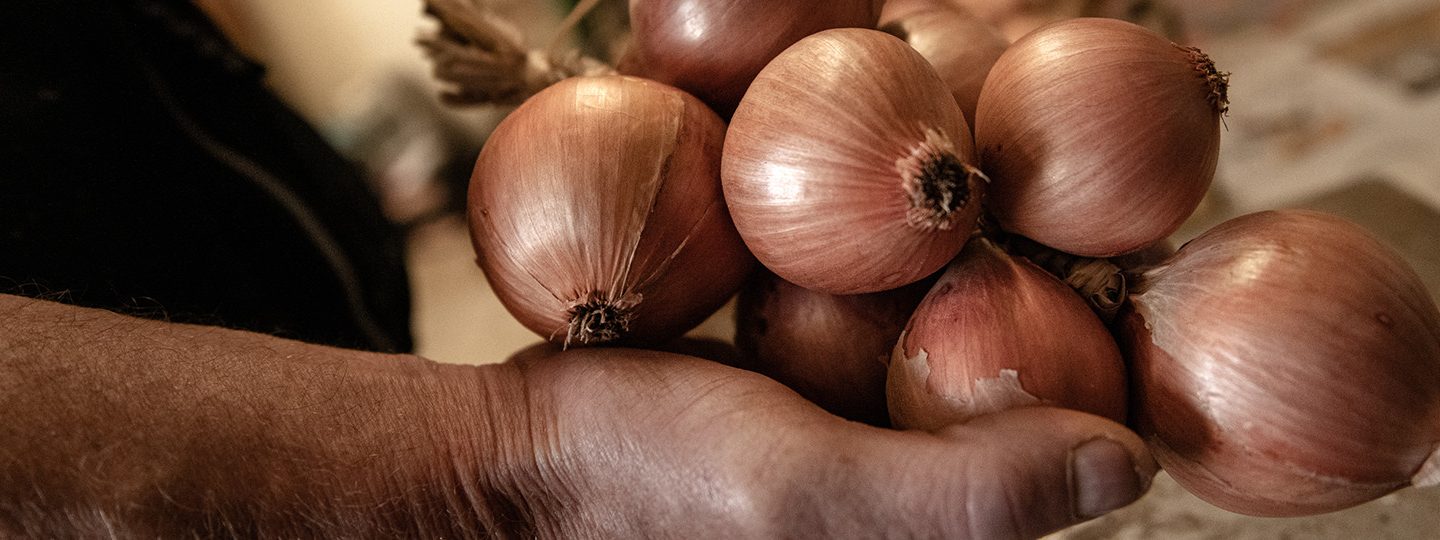Roscoff PDO onions: round, pink, mild, juicy, slightly sweet, and delicious both raw and cooked. This local allium has all the necessary ingredients to satisfy even the most demanding of gourmets. We offer them in net bags, trays, Girsac and plaits. Let’s take a closer look at plaited onions, which allow you to offer your clients a high-end product at an affordable price. To learn all the secrets of Roscoff PDO onion plaits, we met with onion grower and plaiter Alain Rosec, whose farm is located a few kilometres from Pouliquen’s head office.
Alain Rosec: Roscoff PDO onion grower in Sibiril
Alain Rosec, a strapping man in his fifties with a twinkle in his eye, is the third generation of his family to run Keraval farm in Sibiril, Finistère. On his land overlooking the Channel, he grows cabbage, red kuri squash, sand carrots, garlic and Roscoff PDO onions. Like his father and his grandfather before him, Alain farms this land with passion. ”I find it interesting to grow vegetables, to feed people, though it’s not always easy.” Since he took over the farm in 1990, Alain has chosen to work alone. Alain is a member of the SICA Prince de Bretagne agricultural cooperative.
Roscoff PDO onions: 100% manual production
One of the unique features of the Roscoff PDO onion is that it is produced entirely by hand. This year, Alain planted a 1/2 hectare of this typical local onion on his 14 hectares of land, and harvested around 20 tonnes of onions. Like every spring, he plants his onions in seed blocks. This method allows the onions to be planted later in the season, meaning that they begin their field growth more quickly thanks to milder weather conditions.
“I plant my onions on plastic shallot film, so that they’re not in direct contact with the soil. They’re “clean” when I harvest them. The time I spend laying down the film is balanced out by the time I save on cleaning the onions before plaiting. The film is then collected and recycled by the company I buy it from.”
After harvest, the onions are stored in ventilated silos to ensure their preservation. Only the alliums reserved for the end of the season are refrigerated. These are removed from refrigeration as the orders begin to roll in April.
Roscoff PDO onions: plaited by hand
Alain has been manually plaiting his entire Roscoff PDO onion harvest for over 10 years. This season, he himself will make almost 20,000 Roscoff PDO onion plaits. Before being plaited, the onions are sorted by calibre: large (50–60), medium (40–55) and small (30–40). Alain’s plaiting technique is confident and professional. He described his method:
”I use a sheet of brown paper to make the plait more rigid. I wind the raffia around a couple of times. I take a large onion for the bottom of the plait, then three small ones, and then I move up 5 centimetres. I add three medium onions, and move up again. Then I add three large onions. I make a knot, a loop, and voilà. It takes 10 onions to make a 1-kilogram plait.”
The scales show 1.04kg, proving Alain’s mastery of the process.
”At first, onion plaits were a niche product for small growers like me. Nowadays, more of us are offering plaits. But I’m still doing it. It keeps me busy in winter, and I enjoy it.”
Roscoff PDO onion plaits: quality and preservation
A plait of onions resembles a bunch of grapes and has a loop on the end so it can be hung up. When stored in a cool, dry place, plaited Roscoff PDO onions can be preserved for up to 8 months. Indeed, in addition to its aesthetic aspect, onion plaiting lengthens the shelf life of these alliums, as the tightly-wrapped stems make it more difficult for the onions to sprout. Both attractive and practical: Roscoff PDO onion plaits truly have everything going for them.
